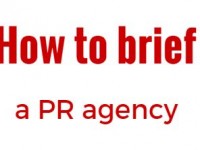With the start of the new financial year just around the corner, many companies are reflecting on how the year has gone and whether it’s time to update their PR strategy, commission a new PR project, look for a new agency, or simply fulfil their due diligence by putting their PR work out to competitive tender. If you’re in that position then writing a really great brief can reap dividends – ensuring that you know exactly what you want and appoint an agency that can deliver the results you need.
Make sure that you start by providing a good company background/ overview and then go on to provide clear objectives, positioning, audience, reporting methodology, budget and the tender process:
Background / overview
Providing an agency with details about your company is key, a comprehensive background will ensure that proposals clearly take into account the company’s current position, what it has to offer, who its target audience is and what its key differentiators are. After all it’s not in anyone’s interest to have to read or sit through a proposal that is wide of the mark, and a waste of valuable company time. The background should include:
- Comprehensive company overview - what does the company ‘offer’, which factors influence growth/ decline and what are the company’s business goals.
- Clients and market share – which sectors does the company operate in, who are the key clients and what is the current market share.
- Current and past marketing activity – what is the current marketing activity, are the bloggers and journalists with whom the company currently works, what is the company’s past experience of working with a PR agency.
- Competition – are they national, regional, international.
- USP – what key differentiators set the company apart.
PR campaign
Summarise your goals and objectives, what do you want a PR agency to achieve, why now and why this piece of work? Thinking about this carefully now, will ensure that you have a campaign that delivers tangible results that meet or exceed your expectations.
- Headline PR objectives – What should success look like and how will the company benefit from this view of success. Is your campaign brief aligned with all the stake-holders, getting buy-in from everyone at this stage will gain greater commitment to the campaign once it is up and running.
- Current positioning – How is the company currently viewed by your target audience - and who is the target audience.
- Target positioning – How would you like the company to be viewed by your target audience.
- Reporting – How should the results of the campaign be reported, what form of measurement is realistic and will show that the campaign objectives are being met.
- Timeline – When should the campaign start and how long should it last
- Budget – Even if a figure can’t be disclosed a rough figure is important. Many agencies will not submit a proposal without a budget and with good reason – it wastes both your time and theirs if they present a campaign that is too big for the budget, or too conservative to achieve key goals.
Tender process
And last but not least, what are the key steps and dates in the tender process. Who are the key contacts and what format should the proposal take. An outline of the selection process keeps everything clear from the start.
To find out about how Vitis PR can deliver tangible results PR for your company call: 0121 242 8048









